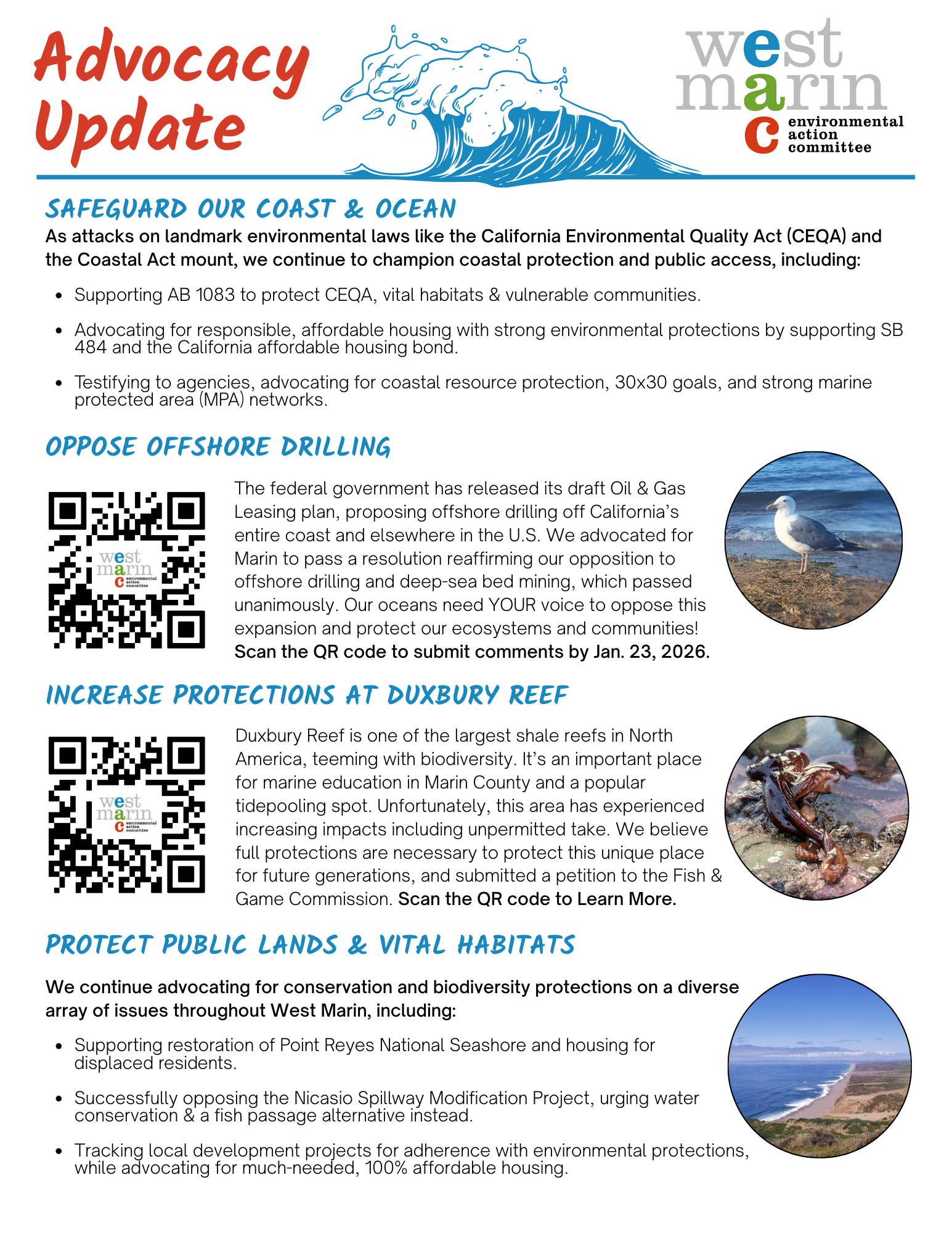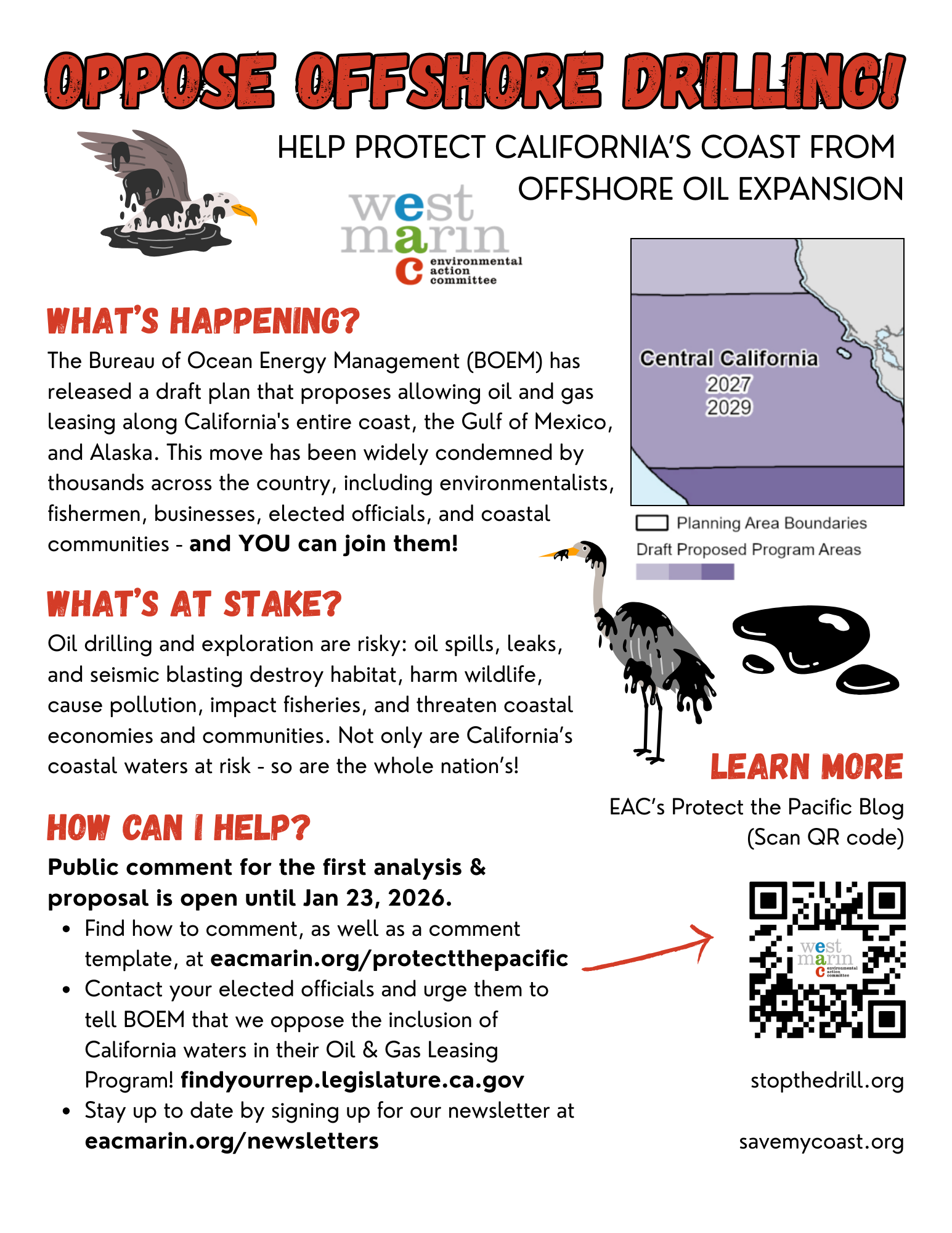Advocate: Protect What You Love and Take a Stand Today!
“Never doubt that a small group of thoughtful committed individuals can change the world. In fact, it’s the only thing that ever has”
Advocacy starts with you.
Advocates help keep our environment healthy by noticing problems and taking action to raise awareness and to change behaviors, attitudes, and laws.
There are many ways to advocate. You choose how you help. All you need is your passion and willingness to be involved.
By caring about the environment, you're already an advocate!
Below are current opportunities where you can take a stand to help protect what you love. The below list will be updated periodically by the team at EAC.
Safeguarding our Coast & Ocean
Protect the Pacific from Offshore Oil
The Bureau of Ocean Energy Management (BOEM) has released a draft plan that proposes allowing oil and gas leasing along California's entire coast, the Gulf of Mexico, and Alaska. This move has been widely condemned by thousands across the country, including environmentalists, fishermen, businesses, elected officials, and coastal communities. Oil drilling and exploration are inherently risky: oil spills, leaks, and seismic blasting destroy habitat, harm wildlife, cause pollution, impact fisheries, and threaten coastal economies and communities. Advocacy up and down California's coast has established ordinances restricting oil and gas development in many of our counties, but the devastating impacts of oil drilling don't care about jurisdictional lines - our marine ecosystems are interconnected, and an oil spill anywhere hurts us all.
State of California, Marine Protected Area (MPA) Decadal Review
California's network of 124 MPAs are 10 years old! Check out the report of the last 10-years that outlines what's working, what's needed, and how MPAs help support ecosystems with changing ocean conditions. Learn More.
Marin Marine Protected Area (MPA) Watch
MPA Watch is a network of programs that support healthy oceans through community science. MPA Watch trains volunteers to observe and collect data on human uses of coastal and marine resources inside and outside marine protected areas (MPAs). Volunteers use standardized protocols to collect relevant, scientifically rigorous, and broadly accessible data.
Join the team this summer. Learn More about how to become a volunteer.
Coastal Resilience and Planning
County of Marin, Stinson Beach Adaptation and Resilience Collaboration (ARC)
What sea level rise adaptation options are available to the Stinson Beach community? What would they look like, and what are their associated benefits and drawbacks? The County will hold popup workshops, surveys, and stakeholder focus groups. Interested in getting involved in the Stinson ARC project? Learn More and sign up for upcoming meetings.
Tomales Sea Level Rise Adaptation Survey
Help UC Davis doctoral student Julie Gonzalez by completing a survey about Tomales Bay and sea level rise. With this survey, Ms. Gonzalez is gathering data to better understand how community members view estuarine habitat restoration. English Version / Spanish Version
Protecting Public Lands
California State Parks, Tomales Bay State Park, Ecological Restoration Plan
In case you missed it, a draft Tomales Bay State Park Ecological Restoration Vegetation Treatment Guidelines report was released in December 2022 for public review. State Parks held a virtual community meeting in December 2022 related to the Report and is currently accepting public comments. We encourage you to get engaged on this issue. Watch the Online Meeting
Point Reyes National Seashore, Tomales Point Area Plan
The National Park Service (NPS) is updating its management planning for the Tomales Point area of Point Reyes National Seashore. Development of a new plan is based on the severity and frequency of two historic droughts in Marin County over the last decade and impacts to tule elk and other resources within the Tule Elk Reserve at Tomales Point. Current management guidance for this area did not anticipate these drought conditions or consider climate change. NPS initiated civic engagement for the Tomales Point Area Plan with a 30-day public comment period beginning March 31, 2022, with the original comment period extended for seven days until May 9, 2022. NPS received more than 4,000 pieces of correspondence during this time. With this announcement, NPS has posted a summary report of these comments and all correspondence on the park's Tomales Point Area Plan public comment web page.
Project Timeline & Public Engagement Opportunities:
Summer 2023: Public scoping and environmental assessment, 30-day public comment period and meetings.
NPS develops the environmental assessment for the Tomales Point Area Plan
TBD: Environmental assessment released for 30-day public review & comment period, including public meetings.
Summer 2024: Final decision.
Reducing Trash & Toxins
Become a Coastal Steward! Discover, Connect, and Respect the Marin County Coast
More than 2.5 million people visit coastal Marin County each year to enjoy scenic coastal villages and public lands for hiking, biking, boating, and dining. So many visitors have significant impacts. You can learn how to reduce your footprint and become a stewards who helps to protect the lands, waters, and biodiversity for current and future generations by being prepared, reducing waste, and connecting with the environment and community. Learn more and download your FREE version of the Stewardship Guide today!
EAC's Litter Bugs Me Roadside Clean Up
Let’s face it our roadways get trashed! As an unincorporated gateway community to three national parks, three state parks, open space, and agricultural lands, as well as a residential community, West Marin is a hot spot for Bay Area recreation and trash. Join a roadside crew in your community to help keep our roadways, creeks, and beaches clean! Learn more about spring and fall volunteer dates and sign up as a volunteer today!
West Marin: Glean Team
The West Marin: Glean Team is a West Marin Food Systems Group project in partnership with ExtraFood, UC Cooperative Extension, and West Marin Climate Action. The Team works with food pantries, schools, and older adult housing sites to donate gleaned produce and products. We aim to pick up and harvest surplus produce from farms and then direct it to senior housing, food pantries, and schools that serve community members in need. We create a pathway for the farmer to impact food insecurity positively.
West Marin Food Systems
The West Marin Food Systems Group works collaboratively with schools, climate action groups, agriculture stakeholders, non-profits, government entities, health care practitioners, and safety net providers to increase access to healthy food for low-income residents and older adults in West Marin to create sustainable community food resilience within our unique foodshed. Our goal is to enhance policy, systems, and environmental changes by identifying available resources, leveraging the expertise of partnerships, and showcasing best practices.
Protecting Biodiversity & Migratory Corridors
Marin / Sonoma Western Monarch Working Group
The Marin and Sonoma Western Monarch Working Group brings together experts, environmental organizations, and community members to collaborate and partner on western monarch butterfly conservation. Members of the public are encouraged to get engaged to learn about actions anyone can take to help support monarchs and other pollinators. The working group meets monthly and helps local projects with native pollinator and milkweed plants. Learn More
California 30x30
In October 2020, Governor Newsom issued Executive Order N-82-20 which establishes a state goal of conserving 30% of California’s lands and coastal waters by 2030 – also known as 30x30. The 30x30 goal is intended to help accelerate the conservation of our lands and coastal waters through voluntary, collaborative, action with federal and local governments, California Native American tribes, and private landowners. The 30x30 Partnership to support the implementation of 30x30 and to engage and empower all partners working toward its objectives. The 30x30 Partnership is an alliance of groups and leaders advancing 30x30 and is open to all who are interested in participating. Learn More





